REDESIGNING FREEDOM REDESIGNING FREEDOM

















Cathy Jennings, Chair Tom Wills, Bruce Doeg, Demetria Kalodimos, Ann Bourland
Amanda Haggard • Linda Bailey • Hannah Herner • Jennifer Alexander • Bailey Basham
• Tom Wills • Ridley Wills II • Joe Nolan • Barbara Womack • Alvine • Erica Ciccarone
• Treena Do • Mr. Mysterio • Jennifer A. • Chris W. • VIcky B. • Wild Bill • June P. • Carla B. • Danny
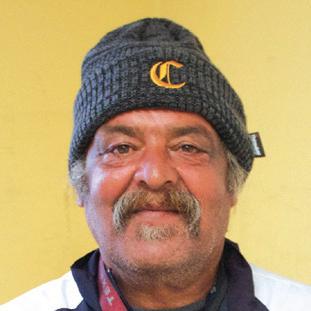





Cathy Jennings

• Tom Wills • Joe First
• Andy Shapiro • Michael Reilly • Ann Bourland • Patti George • Linda Miller • Deborah Narrigan • John Jennings • Barbara Womack • Colleen Kelly • Janet Kerwood • Logan Ebel • Christing Doeg • Laura Birdsall
• Nancy Kirkland • Mary Smith • Andrew Smith • Ellen Fletcher • Michael Chavarria
Will Connelly, Tasha F. Lemley, Steven Samra, and Tom WIlls Contributor Co-Founders
Editorials and features in The Contributor are the perspectives of the authors. Submissions of news, opinion, fiction, art and poetry are welcomed. The Contributor reserves the right to edit any submissions. The Contributor cannot and will not endorse any political candidate.

Submissions may be emailed to: editorial@thecontributor.org
Requests to volunteer, donate, or purchase subscriptions can be emailed to: info@thecontributor.org Please email advertising requests to: advertising@thecontributor.org







Mailng Address

The Contributor P.O. Box 332023, Nashville, TN 37203
Editor’s Office: 615.499.6826 Vendor Office: 615.829.6829



Proud Member of:





Printed at:
Follow The Contributor:
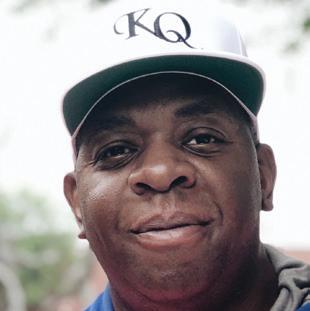

Copyright © 2018 The Contributor, Inc. All rights reserved.
 Cathy Jennings Executive Director
Andrew Krinks Editor Emeritus
Cathy Jennings Executive Director
Andrew Krinks Editor Emeritus
In order for us to fully appreciate the celebration of Black History Month, looking back at North America before 1926 when Black History Month was established is imperative.
In the time between 1619 and 1926, African-Americans were classified by many as a race that “had not made any contributions to human civilization,” according to a piece of writing from 1997 by Vanderbilt’s Felix Boateng. In the piece, Boateng says African-Americans were continually dehumanized and relegated to the position of non-citizens and often defined as fractions of humans.
“It is estimated that between 1890 and 1925, an African-American was lynched every 2.5 days,” the piece of writing says.
The pieces goes on to describe that African Americans were so dehumanized and our history so distorted in academia that slavery was considered by many to be a justifiable condition.
It was this kind of climate that inspired the talented and brilliant African-American scholar, Dr. Carter G. Woodson to lead in the search for truth and to institutionalize what was then referred to as Negro History Week.
Woodson is quoted as saying: “If a race has no history, if it has no worthwhile tradition, it becomes a negligible factor in the thought of the world and it stands in danger of being exterminated.”
Woodson, who had a PhD from Harvard, dropped out of academia to devote his life to the scientific study of the African experience in America, Africa and throughout the world. He was a powerful factor in Negro History Week being launched in 1926 in hopes of neutralizing the apparent ignorance and distortion of Black History.
What was created as Negro History Week has been expanded to encompass the whole month of February in order to examine the collective ingenuity, creativity, cultural and political experience of the masses of African-Americans.

Boateng writes that Black History Month should be the reaffirmation of struggle and determination to change attitudes, and to heighten the understandings of the African experience. It challenges the present-day White and Black generations alike to protect and to preserve the humanity of all peoples of African descent.
The significance of February is that many African-American birthdays — as well as other important events — happened in the month: Frederick Douglass, The Great Emancipator and publisher, Poet and Writer Langston Hughes, and Pianist Eubie Blake were born in February.
As for events, the National Association for the Advancement of Colored People was founded in February. Abraham Lincoln, who attempted to free all slaves with his “Emancipation Proclamation,” was born in February as well. W.E.B. Dubois, the founder of the NAACP, was also born in February. The 15th Amendment granting Blacks the right to vote was passed in February and Malcolm X died in February.
So the month of February is designated as Black History month, but in reality, it is a time of reflection for all races to find common ground and to bring civility back into the world. We are one race, the human race, and if we are not careful, if we do not protect the earth and protect each other, we will all be history!
“We all have the responsibility to help each other.” Kobe Bryant.
Pedro unfolds a piece of paper he pulled out of his wallet. It’s delicate, and has a hole in the middle, but the key piece of information is still intact. It lists his former salaries. That was back when he worked in a steel mill in Texas, after he cleaned up the 2010 flood damage in Opry Mills, but before his leg was severely injured in an accident. After working for seven years in pain, he couldn’t take it anymore. When he came back to Nashville in 2019, he went straight to the Nashville Rescue Mission.
“I was at $57,000 for the year. And to go to nothing was devastating,” he says. “I came to Nashville with nothing.”
As an army cook, a garbage collector, a construction worker and
a factory worker, Pedro had always worked long hours — often 12-hour days. He once went two and a half months without taking a day off.

“Finally they said, ‘Pedro, you have to take a day off,’” he laughs.
What drove him to work so incessantly were his two daughters, whom he raised as a single dad since they were 10 and 8 years old.
“Eventually, [their mother] signed custody over to me, and I raised them by myself. I had to work every day to support my kids,” Pedro says. “It was very hard. I wasn’t there. I always had to go to work to provide for them.”
Pedro is keen to share about his experiences. He wants people to understand where he’s coming from. When asked what he would say to
BY HANNAH HERNERother single dads he says, “Don’t lose faith. It’s really hard. Just do the best you can. That’s all I could do. It’s a struggle, but don’t give up.”
Pedro has a lot of stories to share, usually starting with “Oh, I didn’t tell you this!” He grew up in Chicago with three brothers — one of them is his twin. He was sent home from kindergarten because he couldn’t speak English, and went back the following year, having learned it. His family used to host kids in the foster care system. They used to have big birthday parties in his yard in Chicago, complete with a live rock band. He just happened to be at the infamous Disco Demolition Night in Chicago, where a White Sox gimmick blowing up a crate of disco records descended
into chaos. As a teen, he got mad at his dad and hitch-hiked across the country. He didn’t know what to do next so he called the police on himself. He waited outside the Chicago Bears stadium for three days, so he could be the third person to get tickets to watch them in the playoffs. He helped build the Brentwood Target, Velocity in the Gulch and a fire station in Hermitage. He loves watching Chopped Things are looking up for Pedro. He recently got into the Salvation Army men’s shelter, a move that he says gives him peace of mind. He had surgery on his injured leg, which relieved some of the pain. And he’s found a spot to sell where customers care about him.
“A couple people tell me thank
you for being there, and when I’m gone, they wonder where I’m at,” he says. “I had to leave for three weeks, and they were worried about me.”
Pedro doesn’t hesitate to say that he’s “had a hard life.” Coming back to The Contributor has been an adjustment for him, but he’s come to believe that he’s still doing good work.
“In the future I want to get my own place, and I’m working on my disability,” Pedro says. “I’d love for Nashville to be happy. Sometimes people think it’s a sad city. I want to change Nashville, I do. I want to change how people think about the vendors. A lot of people don’t know your situation. If they knew your situation they’d have a better perspective of a vendor.”
The paper you just paid for was bought by someone else first, otherwise it wouldn’t exist. That’s how The Contributor works. A vendor who experienced homelessness paid 50 cents for this paper and then sold it to you. By buying it and taking it with you, you’ve just encouraged that vendor to buy another. BOOM! That’s the solution. Now keep reading. This paper has something to say to you.
Street papers provide income for the homeless and initiate a conversation about homelessness and poverty. In 2007, The Contributor founders met at the Nashville Public Library downtown to form one. In a strike of lightning we named it The Contributor to infer that our vendors were “contributors to society,” while their customers could contribute to their work. But, thunder from lighting is always delayed …
It took three years, but Nashville embraced us like no other city in the world. The Contributor became the largest selling street paper per-capita on the globe. And today 50 percent of our six months or longer tenured vendors have found housing. BOOM! The thunder has struck.
The Contributor is a different kind of nonprofit social enterprise. We don’t serve meals or provide emergency shelter. We don’t hire people in poverty to create products or provide a service. Rather, we sell newspapers to homeless people who work for themselves. We train them to sell those papers to you, keep the money they earn, and buy more when they need to replace their stock.
Our biggest fans don’t always get this. Like lightning without the thunder, they see the humanity of the vendor but misunderstand the model. Case in point: In 2013 during a funding crunch, a representative of one of Nashville’s biggest foundations exclaimed, “I’m such a big fan that I never take the paper!” We responded, “Well, that’s why we are in a funding crunch.” BOOM! Thunder was heard. Taking the paper makes our model work — not taking it breaks it.
And selling the paper twice doesn’t just fund the paper, it funds housing and change. BOOM! Our vendors report their sales to qualify for subsidized housing and even for standard housing deposits and mortgages. They don’t consider your buying the paper a “donation.” It is a sale. When they sell out, they buy more and build the paper trail of a profitable business. Until making these sales, many of our vendors had never experienced the satisfaction of seeing their investment pay off. And when it does, it liberates! They have become “contributors” to their own destiny. And Nashville has become a city of lightning and thunder. BOOM!
Now that you are a SUPPORTER , become an ADVOCATE or a MULTIPLIER
You are already a SUPPORTER because you know that taking the paper makes the model work. You bought the paper and you are reading it. Now your vendor is one copy closer to selling out, which is exciting!

Now you can become an ADVOCATE when you introduce your friends to your favorite vendor, follow us and share our content on social media, contact us when you witness a vendor in distress or acting out of character, or explain why others should pick up a copy and always take the paper when they support a vendor.
And, you can become a MULTIPLIER when you advocate for us AND directly donate to us or become an advertiser or sponsor of The Contributor. Our income stream is made of 50-cent- at-a-time purchases made from our vendors, matched by contributions, ad sales and sponsorships from multipliers like you. Because our vendors are business owners, your donations are seed-money investments in their businesses and multiply in their pockets. Every donated dollar multiplies four-to-seven times as profits in the pockets of our vendors. Thanks for contributing.
El periódico que usted acaba de pagar fue primeramente comprado por alguien mas, de otra manera no existiría. Así es como funciona The Contributor. Un vendedor que está sin hogar pagó 50 centavos por este periódico y después se lo vendió a usted. Al comprarlo y llevarlo con usted, usted animo a este vendedor a comprar otro. BOOM! Esa es la solución. Ahora continúe leyendo. Este periódico tiene algo que decirle. Los periódicos vendidos en la calle proveen ingresos para las personas sin hogar e inicia una conversación sobre lo que es la falta de vivienda y la pobreza. En el 2007, los fundadores de The Contributor se reunieron en una librería pública en Nashville para formar uno. Y como golpe de un rayo, le llamamos The Contributor para dar a entender que nuestros vendedores eran “contribuidores para la sociedad,” mientras que los consumidores podrían contribuir a su trabajo. Pero, el trueno siempre tarda más que el rayo. Nos llevó tres años, pero Nashville nos acogió como ninguna otra ciudad en el mundo. The Contributor se volvió uno de los periódicos de calle más vendido en el globo. Y hoy el 50 por ciento de nuestros seis meses o más de nuestros vendedores titulares han encontrado casa. BOOM! Ha llegado el trueno.
JENNINGSThe Contributor es una empresa social sin fines de lucro muy diferente. Nosotros no servimos comida or proveemos alojo de emergencia. No contratamos gente en pobreza para crear productos or proveer un servicio. En vez, nosotros vendemos periódicos a las personas sin hogar para que ellos trabajen por ellos mismos. Nosotros los entrenamos como vendedores, ellos se quedan el dinero que se ganan, y ellos pueden comprar más cuando necesiten reabastecer su inventario.
Nuestros mas grandes aficionados no entienden esto. Como un rayo sin trueno, ellos ven la humanidad de el vendedor pero no comprenden el modelo. Un ejemplo: En el 2013 durante un evento de recaudación de fondos, uno de los representantes de una de las fundaciones más grandes de Nashville, exclamó: “Soy un gran aficionado, y es por eso que nunca me llevo el periódico.” Al cual nosotros respondimos: “Y es por esa razón por la cual estamos recaudando fondos.” BOOM! Y se escuchó el trueno! El pagar por el periódico y llevárselo hace que nuestro sistema funcione, el no llevarse el periódico rompe nuestro sistema.
Y el vender el papel dos veces no da fondos para el periódico, pero da fondos para casas y causa cambio. BOOM! Nuestros vendedores reportan sus ventas para calificar para alojamiento subvencionado y hasta para una casa regular, depósitos e hipotecas. Ellos no consideran el que usted compre el periódico como una “contribución” pero más lo consideran como una venta. Cuando se les acaba, ellos compran mas y asi logran establecer un negocio rentable. Hasta que lograron hacer estas ventas, muchos de nuestros vendedores nunca habían experimentado el placer de ver una inversión generar ganancias. Y cuando logran hacer esto, da un sentido de Liberación! Ellos se han vuelto contribuidores de su propio destino, y Nashville la ciudad de el trueno y el rayo. BOOM!
Ahora que te has vuelto nuestro SEGUIDOR, vuelve te en un ABOGADO o un MULTIPLICADOR. Ya eres nuestro SEGUIDOR, porque sabes que al llevarte este periódico sabes que esto hace que nuestro modelo funcione. Compraste el papel y lo estas leyendo. Ahora nuestro vendedor está a una copia más cerca de venderlos todos. Que emoción!
Ahora que te has vuelto nuestro ABOGADO cuando presentes a tus amigos a tu vendedor favorito, siguenos y comparte nuestro contenido en social media, contactanos cuando seas testigo de un vendedor actuando de manera extraña o fuera de carácter. O explicale a tus amigos porque ellos deben de llevarse el periódico cuando ayuden a un vendedor.
Te puedes volver un MULTIPLICADOR cuando abogues por nosotros, Y directamente dones a nosotros o te vuelvas un anunciador o patrocinador de The Contributor. Nuestra fuente de ingresos consiste en ventas de 50 centavos hechas por nuestros vendedores, igualadas por contribuciones, venta de anuncios, y patrocinios de multiplicadores como usted. Porque nuestros vendedores son dueños de negocios, las donaciones que den son dinero que es invertido y multiplicado en sus bolsas. Cada dólar donado se multiplica de cuatro a siete veces en la bolsa de nuestros vendedores.
Gracias por Contribuir.United Street Tours is a Nashville tour company. Founded February 2018, it showcases the lesser known history of Nashville that educates, informs and inspires.
TOUR INFORMATION:
Nashville Black History Walking Tour, Feb - Oct 2020, 9 a.m.
Murals, Music, and Museums Walking Tour Feb - Oct 2020, 1 p.m.
Visit unitedstreettours.com for more information.
During Black History Month, locals don’t have to travel far to visit sites that are significant to Black History.
On Feb. 1, 2020, United Street Tours launched pair of two-hour Nashville tours in downtown Nashville and the North Nashville community, according to a release. The downtown tour is called the Nashville Black History Walking Tour and it takes you on a historical journey from slavery to freedom. The North Nashville tour is called Murals, Music, and Museums Walking Tour — it’s a
glimpse into the present state of Black Nashville through murals and music. The founder of United Street Tours, Chakita Patterson, organized these tours to use history to bridge the gap between two distinct Nashville communities.

The Nashville Black History Walking Tour celebrates the past through storytelling about Nashville’s enslaved population by spotlighting people such as Robert “Black Bob” Renfro.


Renfro, a former slave, became a successful entrepreneur in 1794, when he in 1794 when he received a license to sell liquor.
He opened a tavern called Black Bob’s Tavern and his commemorative pillar is a major highlight on the tour, organizers said. While the Nashville Black History Walking Tour gives you a look into the past — the tour in North Nashville is an upbeat experience that focuses on the current and future state of Black Nashville through art and blues music history. It offers an insightful look into murals that have a social justice theme such as the “Gateway To Heritage” by James Threalkill and Michael McBride.
“Black history is multi-dimensional. It encompasses murals, hot chicken, blues music, fashion, natural hair, and other aspects of black culture” says Chakita Patterson. “Our walking tours are a significant way to experience black history because they allow you to actually stand where civil rights leaders stood and demanded inclusion. They allow you to feel the passion local artists felt during the creation of murals. Our tours also allow both Nashville natives and newcomers to connect with the local community on a deeper level.”
We have come well past the age of the “selfie.” The truth is, I don’t ever get them right. I don’t know where to look. I am usually looking at the background I want in the picture and then I just get a little of my face. When I do get my face, it accurately reveals that I am concerned where to look at the phone. I marvel at those who seem to take hundreds of pictures of themselves every week. While I might stay too long at the pool of narcissism, I still don’t fully understand the selfie. I guess I do, however, understand the desire to be at the center of one’s own world. I think this started in a garden.
What’s even further disturbing is we often value where we find meaning in life more by the value of place than by the value of the experience. Once while in grad school, we came home from a great vacation. We lived in Boston and went to Pittsburg, NH for a great snow filled weekend. We got back to school, the kids excited and refreshed. In contrast, our friends shared about their trip to Switzerland to go skiing and how taxing the flights were. It seemed that their place of snow across the world seemed much more valuable than our place of snow up the road, even though we seemed to have enjoyed our snow more.
I believe and have experienced this is true of many of the great things of life; a Sunday afternoon on a porch, a
meal with friends, an evening of entertainment, and even healthcare. A 2018 Pew Research Study “Where Americans Find Meaning in Life” found we find meaning in family, friends, religion, career, healthcare, and a place to walk the dog. After these priorities, we focus on housing and surroundings. Can you relate? Is this reflective, or near reflective, of how you find meaning?
What is amazing is I find this true also of the impoverished, even the most impoverished, amongst us. For six years, The Salvation Army has been asking residents of our shelters and supportive housing to prioritize their well-being goals. They reflect America, of course. The challenge is how we look at that picture. When we look at it through a selfie, it most often doesn’t make sense. How can that person appreciate living in a tent along the river, with those people, spending their days chasing basic human needs and finding solace in the vacation of seasonal church living. Huh? Our neighbors find meaning in the same places, the same experiences, that we do. However, their worldly experience of those things have quite a different value, to us. But their goals of well-being are the same.
A great challenge in this conversation is not only the quality of life experience, but also the length of life
challenge. On average those who experience chronic homelessness die twenty-five (25) years earlier than those of us who are housed. We live in the same places, find meaning in the same living, but it costs them 25 years of life. Our challenge, my leadership challenge, is do I let their loss of life reduce my quality of life? Yes, it is ok to take a selfie on the issue. Does it bother me enough to change my behavior? Does it bother you?
Join the #FightForGood. Help our neighbors experience the meaning of life for another five, ten, twenty-five years. Reflecting the quality of community in the lives of others increases the quality of life of us all. Lord, have mercy on us.
(A personal note of thanks to honor Uncle Brad’s memory as he lived out this wisdom.)
Major Ethan Frizzell serves as the Area Commander of The Salvation Army. The Salvation Army has been serving in Middle TN since 1890. A graduate of Harvard Kennedy School, his focus is the syzygy of the community culture, the systems of service, and the lived experience of our neighbors. He uses creative abrasion to rub people just the wrong way so that an offense may cause interaction and then together we can create behaviorally designed solutions to nudge progress. Simply, negotiating the future for progress that he defines as Quality of Life in Jesus!
Feb. 8, 16, 23 | 2 to 2:30 p.m.
Stones River National Battlefield, 3501 Old Nashville Hwy, Murfreesboro
Rangers will share a free 30-minute talk exploring one of the many ways African American stories are connected to the park’s landscapes.
Feb. 10, 11, 24 | 10 a.m. to 2 p.m.
Microsoft Store, Mall at, 2126 Abbott Martin Road, Nashville
This free event will help kids learn to create and share their own digital art with the Fresh Paint app for Windows 10, and then create their own artwork related to Black History Month. Feb. 11’s event is from 6 p.m. to 8 p.m.
Feb. 12 | 11:30 a.m. to 1 p.m.
Nashville Airport Marriott, 600 Marriott Dr., Nashville
February 2020 Cable Luncheon: Celebrate Black History Month With Shani Jackson Dowell Keynote
Nashville Cable celebrates Black History Month with Possip founder and CEO Shani Jackson Dowell, the first black woman from Tennessee to raise more than $1 million in venture capital funding. Though she is now
also an experienced tech CEO, Dowell is a parent and educator at heart.
Feb. 14 | 9 a.m. to 4 p.m.
Tennessee State University - Avon Williams Campus, 330 10th Ave. S., Nashville
39th Annual Conference on African American History and Culture

The Tennessee State University’s College of Liberal Arts and the Metropolitan Historical Commission is hosting the 39th annual Nashville Conference on African American History and Culture. For 39 years, this award-winning conference has brought together historians, students, educators, community leaders and others interested in the contributions of African Americans to Nashville and Tennessee. The theme for this year’s conference is “A Journey from Enslavement to Liberation.”
Feb. 15 | 3 to 5 p.m.
Hadley Park Community Center, 1037 28th Ave N, Nashville
The Black History Showcase
Hadley Park, The Networking Platform and The Black Family Talks have partnered in this free event that highlights the black legends of Nashville such as Avon Williams, Howard Gentry, Z. Alexander Looby, Preston Taylor and Justice AA Burch.
Feb. 15 | 7 to 11:30 p.m.
Track One, 1201 4th Ave S, Nashville
The Vanguard Art Show: Black History Project
This is the fourth annual black history themed art show at Track One, which features art as well as music.
Feb. 21 | 7:30 to 10:30 p.m. Nashville
Sofar Nash | North Nashville | Black History Month
This event aims to shine a light on the talented black voices in Nashville. Sofar cities across the country are celebrating Black History Month with shows featuring three amazing artists performing a mix of genres. From Germantown to Berry Hill to North Nashville, organizers are hosting intimate, stripped down shows in unexpected places with three-artist lineups you would never see together anywhere else. Visit sofarsounds.com for more details.
Feb. 27 | 6 to 7:30 p.m.
Tennessee State Museum, 1000 Rosa L Parks Blvd, Nashville
This is a free panel discussion on interpreting African American history in public spaces and museums. Panelists include Brigette Jones, director of African Amer-
ican studies at Belle Meade Plantation; Tamar Smithers, Director of Education Programs at the National Museum of African American Music; Marquita Reed, collections manager at National Museum of African American Music; and local music historian Lorenzo Washington of the Jefferson Street Sound Museum Jefferson Street Sound Museum.
Feb. 29 | 11 a.m. to noon

Andrew Jackson’s Hermitage, 4580 Rachels Ln., Hermitage
The Hermitage will host its free annual commemoration of those once enslaved at The Hermitage and throughout the country. Held at The Hermitage Church, the service will feature music and special remarks, followed by a procession to the slavery memorial, “Follow the Drinking Gourd,” located behind the church. One hundred and fifty flowers will be laid, marked with the names of all those known to have been enslaved at The Hermitage.
Feb. 29 | 3 p.m. to midnight
Patterson Park Community Center, 521 Mercury Blvd, Murfreesboro
This is an annual celebration of long-standing community heroes and up-and-coming influential leaders in the Middle Tennessee area.



In 1812 Havana, José Antonio Aponte — a carpenter, artist and veteran of Havana’s free black militia — was arrested on charges of conspiring to plan a slave revolt. The evidence stacked against him included a book of 63 paintings, collages and engravings that featured depictions of black soldiers, emperors, gods and goddesses; scenes from Egypt and Ethiopia; portraits of Aponte himself as a military general; black armies defeating white armies in battle and much more.
Since 1790, some 325,000 Africans were brought to the Spanish colony and forced into labor on sugar plantations — 1812 was still 74 years before slavery would be abolished on the island, and 86 years
before the people of Cuba would win independence from Spain. Part manifesto, part historical document, part memoir, Aponte’s Book of Paintings mapped out revolutionary strategies and imagined a free, sovereign nation.
During his trial, Aponte was forced to provide testimony explaining each image in the book. Aponte was executed shortly after. The transcripts of his trial survived and are all that remains of this work of art. Now, a group of artists has envisioned the content of that revolutionary book.
On view at Vanderbilt Fine Arts Gallery, Visionary Aponte: Art and Black Freedom was conceived after a 2015 symposium at New York University, and it first opened at the Little Haiti Cultural Center in Dec. 2017. Curators Édouard Duval Carrié and Ada Ferrer asked artists to rely on these transcripts to recreate Aponte’s vision of a sovereign future for Cuba’s people of color,

and the results are staggering.
“Can you imagine a gentleman, a revolutionary thinker, that used an entire set of illustrations to convey to the people what he wanted to embody?” asks María Magdalena Campos-Pons, an artist in the exhibition and the Cornelius Vanderbilt Endowed Chair of Fine Arts at Vanderbilt University. “This preceded ‘Guernica.’ This preceded Goya. … This is a really amazing metaphorical attempt to understand [how much] agency somebody could have.”
Campos-Pons was born in the province of Matanzas, Cuba, to a family with Nigerian, Hispanic and Chinese roots. She interpreted Aponte’s testimony to create a metaphor for the trans-atlantic journey of enslaved people. Her painting “Five Apparitions” shows a puddle-shaped sea of muddy blue watercolors, with black and gold figures suspended within it. They resemble angels and humans, fish and sea

creatures. It is reminiscent of the artistic and literary tradition of magical realism, which camouflages subversive messaging in fantastical imagery.
“I see that this is present in [Aponte’s] own attempt to use imagination as material for subversion, as material for resistance, as material for rebellion,” says Campos-Pons.
Ferrer helped create the website Digital Aponte, which contains a translation of Aponte’s testimony. Paired with the works of 20 artists in the exhibition, his Book of Paintings comes to life.
The artistic practice of Havana-born, internationally acclaimed painter José Bedia includes anthropological research, specifically the study of African roots in the Americas and how ancestral heritage influences contemporary life. In “Júbilo de Aponte, 2017,” Bedia tells a story that reflects many themes in the Book of Paintings. At roughly 12 by 9 feet, the mixed-me-
dia artwork resembles the general shape of Mesoamerican pyramids. It shows several aspects of Aponte’s text, including depictions of battle scenes that rebels could use as inspiration.
“Júbilo de Aponte, 2017” shows figures riding on a long, sinewy horse; a bell, rooster and small figures in motion occupy the landscape. Above, Bedia has painted a pair of handprints, a pair of footprints and a pair of ears. Above those, people march forward wielding what appear to be machetes. Bedia expresses movement and mobility — agency that feels sacred and graphic. A man’s silhouette — muscular and statuesque — sits atop the pyramidal work. Here, the revolutionary Aponte commands a formidable army.
“Júbilo de Aponte, 2017” reads like both a monument and a mausoleum, symbolizing the possibilities inherent in revolution and its many false starts. Aponte’s execution was gruesome. He was hanged in public on April
9, 1812, and his severed head was placed in an iron cage and displayed outside his Havana home. The critic Seph Rodney writes for the online publication Hyperallergic: “The symbolic essence of decapitation is a decisive, summary removal of the thinking part of the human animal so that the body is rudderless, left without volition or direction. They cut off his head and displayed it in this way to cut off the thinking that there could be such a thing as a revolution on the island of Cuba…”
The abominable treatment of Aponte’s body served as a warning to Cubans: The island’s colonial powers would go to any length to sever revolutionary behavior and ideation.
Much like the Book of Paintings, Visionary Aponte embodies the many often contradictory ideas about how to achieve liberation and what sovereignty means for a people. In one of the more literal works in the exhibition, “Like fire burns in living


flames,” Cuban-born painter Alexis Esquivel depicts Aponte as figure of strength, grace and intellect, conveying Aponte’s desire for radical philosophical discourse that he believed would secure emancipation for the people of Cuba. In the foreground of the painting, a black soldier spears the severed head of a white aristocrat. Esquivel exacts vengeance upon Aponte’s executioners in the context of a philosophical revolution that would decolonize Cuban thought.
Campos-Pons says she is especially happy to see Visionary Aponte in Nashville because of the city’s own history of resistance and civil disobedience.
“There is an interesting kind of circularity including the spirit of desire for liberation and for finding self in Afro-descendents in the Americas,” she says. Campos-Pons hopes that Visionary Aponte will draw students from some of Nashville’s historically black colleges and universities.
“I am interested in history not because I want to be stuck in the past,” says Campos-Pons. “I am interested in history because it allows us to understand better the problems that we have in the present and the past that we need to claim and reveal for the future.
“I think it is an important exhibition because it allows us to reflect on those maladies. It forces us to think about where we are today. What we’re doing that’s right. What we’re doing that’s wrong. What we can improve. What we can do better.”
Visionary Aponte: Art and Black Freedom is on view through March 8. On Feb. 20, Alejandro de la Fuente of Harvard University will present a lecture at 4 p.m. in the Central Library community room. On Feb. 27, Vanderbilt history professor Jane Landers will join Ferrer in a closing reception of the exhibition at 4 p.m. in Cohen Memorial Hall.
 BY JOE NOLAN Film Critic
BY JOE NOLAN Film Critic
If The House by the Cemetery (1981) sounds like a quintessentially 1980s horror film title, that’s because it is a quintessentially 1980s horror film. Like many of the most spooky flicks of that decade, House borrows from 1960s and 1970s cinema while adding contemporaneous touches like a gorgeous and crazed electronic music soundtrack and plenty of turtlenecked yuppie ennui.

The House by the Cemetery is an Italian production directed by Lucio Fulci. Fulci served up nearly every genre of movie during this five-decades-long career, but it’s his horror flicks that made him a cult favorite of fright film fans around the globe. The House by the Cemetery is the third movie in the director’s “Gates of Hell” trilogy, which also includes City of the Living Dead (1980) and The Beyond (1981). Fulci’s trilogy includes some of the director’s most popular films – the movies earned him an international reputation for his extreme content and over-the-top effects, which won Fulci the moniker “Godfather of Gore.” Fulci’s films were often re-edited to receive R-ratings for U.S. releases, but the di-
rector’s X-rated cuts were commonly screened at American drive-ins and in grindhouses where the director’s penchant for sequences featuring injuries to character’s eyeballs delighted rabid audiences of horror film fans.
The House by the Cemetery feels like a loving and sometimes hair-brained homage to much of the best of 1960s and 1970s horror: the synth-sational score recalls John Carpenter’s iconic Halloween (1978) score; Norman’s snake-eyed sneakiness reminds of John Cassavetes leering his way through Rosemary’s Baby (1968); the old-haunted-basement theme had just made a big hit with Amityville Horror in 1979, and the psychic son/going-crazy-mom angle recalls Stanley Kubrick’s 1980 film of Stephen King’s novel, The Shining. Over the years critics of the film have called-out Fulci’s borrowing for a lack of originality. But in 21st century film culture crammed with re-boots and remakes, The House by the Cemetery feels positively postmodern in its smart sampling.
The Shining is also echoed in the film’s plot about a family moving into a spooky old residence so dad can complete a work project. The titular house is a gorgeous Victorian in a state of creepy disrepair — of course! The house in the woods, on the outskirts of the small town of New Whitby, Boston has a mysterious history, and it was the residence of a researcher named Dr. Peterson before he murdered his mistress and committed suicide in the middle of a study of the area’s historic architecture. Norman Boyle is a colleague of Peterson’s. Following the tragic suicide, Norman, his wife Lucy and their son Bob are anxious to leave New York City for several months while Norman completes Peterson’s project. They move into Oak Mansion where they’re confronted by local secrets, neighborhood characters, and the unspeakable truths hidden in their own home.
These throwback vibes are what I really love here, but what separates The House by the Cem-
etery from its influences is that this production comes completely unbound in its embracing of elements that came-of-age in slasher-era of the 1980s: random nudity, bloody gore, and POV camerawork. The House by the Cemetery isn’t necessarily disturbing for 21st century eyes and ears, but the excesses of the production are sometimes so absurd that they heart-warm and stomach-churn simultaneously. The mix of nostalgia and visceral imagery means this is a must-see for Stranger Things fanatics while they wait on season three.
The House by the Cemetery is the Midnight Movie at Belcourt Theatre on Friday, Feb. 7. Go to www.belcourt.org for tickets and times
Joe Nolan is a critic, columnist and performing singer/ songwriter based in East Nashville. Find out more about his projects at www.joenolan.com.
INSP’s #VendorWeek is an annual celebration of the 9,000-plus vendors around the world selling street papers at any one time. Each one of these men and women – in 35 countries – is using their local street paper as a way to work themselves out of poverty.
During the first week in February, our international program of events, activities and social media action pays tribute to their hard work, as well as challenging perceptions of poverty and homelessness. The Contributor is joining in by giving you a glimpse into our vendors’ personalities. Join in on social media with the hashtag #VendorWeek and tell us what you love about your vendor.

Rambo - Charlie A.
Five Feet Apart - Joey S.
All Eyez on Me - Semaj L. Aquaman - Charles L.
Baa Baaa Black Sheep - Richard R.
“When you look good, you feel good!”
That’s Jamie’s motto. It’s why she takes the time to curate a coordinated, colorful, bejeweled, and impeccable accessorized outfit before she goes out to sell the paper each morning. She sells at her spot in Green Hills at Highway 70 and Ridgefield Way starting at 6 a.m., full makeup and decked out.


Jamie says she’s always loved fashion. Her older sister Pam, who passed away in June, was an inspiration.
“When I was five, six years old I remember dragging out her high heels and going clonking through the house. She’d dress me
up, play beauty shop and everything when I was little,” Jamie says.
Jamie gets the bulk of her fashion finds at Walmart or the dollar store, while gifts from customers and Contributor office donations finish off the look. She says even if she had lots of money to spend on clothes, she wouldn’t.

“Some of those celebrities, like say they went to Neiman Marcus, they say that the shoes there cost six or eight hundred dollars. That’s ridiculous! I would not pay that much for a pair of shoes,” Jamie says. “If I was a multi-billionaire I still would not pay it.”
I love bright colors, and people come through here and they go on and on and on about the bright colors.
These [blue boots] were a gift from a customer.”

This sweater was a Christmas gift to myself. This is one of my favorites. I’ve just always loved animal print.
Contributor vendor Shawn L. and I sat down for breakfast at Just Love Coffee to talk about his budding clothing line. He ordered the Flyin’ Pig, his favorite dish, in which bacon, sausage and egg are mixed into a fluffy Belgian waffle. He says it reminds him of his childhood, when he used to mix many different ingredients into his pancake batter.
Shawn has been with The Contributor for more than 10 years, but he conceived the idea of a clothing line before joining us. Creating a clothing line is something he always wanted to do as a way to get his name out. He enjoys both the design and business aspects.
“I always liked the way shirts had little, different designs on them,” he says.
As many of our readers know, Shawn loves to call his customers “kings” and “queens.” His philosophy is, “Everyone has God inside of them. If you are feeling beaten down or blue, pick yourself up and treat yourself like a king or queen — even if just in spirit.” Through his clothing line, he wants to help people express this attitude.
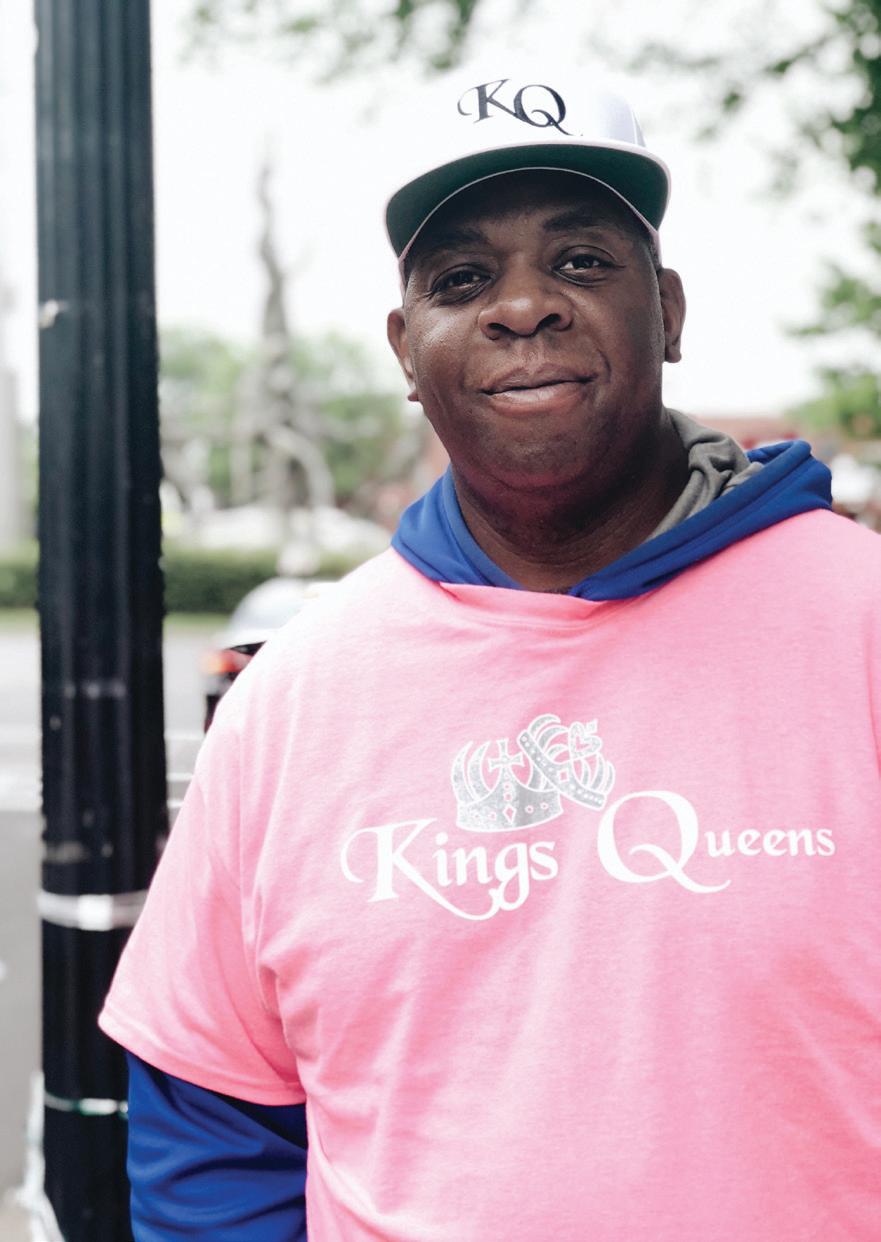
The name of his clothing line, “Kings and Queens,” comes from his
deep love and understanding of God. He came up with the name while he was incarcerated and a teacher introduced him to the Nation of Islam. Through this religion, he was able to develop a deep appreciation for God and desire to help others. He says: “Even when people do wrong on the outside, you’re supposed to see the inside.”
Shawn’s T-shirts and hats come in black, pink and white and they play with the king and queen imagery. He often wears one with his first name across the chest. He plans on tweaking the designs a bit for the next production. He admits that his journey with developing his clothing line has been turbulent.
“It takes money to make money,” he explained. It has been a challenge to manage his money and run his business, but he is not discouraged. He said he’s ready to “fly.”
Ultimately, Shawn wants to inspire others.
“I want to let people know they are better than they think they are, to inspire and help people find their purpose,” he says. “This is the reason I do this, to see people smile.”
Bad Boys - Curtis J. and Eric D. Batman - Dwayne R.
Breakfast at Tiffany’s - Tiffany
Casablanca - Jennifer A.
Child’s Play - Herbert M.
Close Encounters of the Third Kind - Keith D. Cold Turkey - Leslie S.
Coming to America - William H. and Pierre T. Convoy - Michael W. Deliverance - Tom B.
Dirty Dancing - Stacy B.
Dracula - Robert G.
Easy Rider - Dwayne B. Equalizer - Davis H.
The Fast and the Furious - Steven C. Forrest Gump - Tim S., Pedro L, and Eric H. The Godfather - Eddie H. and Albert W.
Gone with the Wind - Tonya H. Grease - James C. Gunsmoke - Bobby W.
It - Cynthia P.
A Thin Line Between Love and Hate - Josh H. Jack Reacher - Anthony B.
James Bond movies - DeWayene S.
The Lego Movie - Ron D.
Lonesome Dove - Stanley C.
The Lost Boys - David W. (Road Dog) Malcom X - Francis W.
Boo! A Madea Halloween - Richard T. Remember the Titans - Dennis S.
“
“
I want to let people know they are better than they think they are, to inspire and help people find their purpose. This is the reason I do this, to see people smile.
After my neighbor Bill died, his house stayed empty for most of a year. First it just sat there, dark, with no A/C running and and no Bill sitting on the front porch. After a few months, some guys showed up and gutted it. That took a while. And then they started to repair and rebuild. That took a long time too. Now today there’s a U-Haul and some kids moving in. Four roommates. I think they have a band. I miss him, but I’m glad the house is alive again. And I’m glad they let it sit empty so long. Don’t rush in to a big changeover, Pisces. Give it a minute to sit.
I’m not much of a DIY type. I grew up in a house where, if something broke, it stayed broken. If the microwave stopped microwaving, we’d just use the toaster oven. If the toaster oven door fell off, we’d all just warm our hands for 45 minutes while we made microwavable burritos. This week, Aries, before you give up on what’s broken, spend a little time thinking about how you might fix it. It might be worth it. It might be fulfilling. Think it over before you throw it out.
Sure everybody knows that St. Valentine is the patron saint of love, marriage and engagements. He gets his own day and everything! But what about St. Apollonia, the patron saint of dentists? Why doesn’t Apollonia get her own day where one aisle of the grocery store is dedicated to tooth shaped chocolates and greeting cards woven from dental floss? Not everybody gets a day, Taurus. But just so you know, I really do appreciate you.
Most people feel like “the holidays” are already over. For me, things are just getting started. I’m not talking about Valentine’s day here, people. Ladies and gentlemen, in case you haven’t noticed, we are right in the middle of Lobster Fest 2020. Close your eyes and picture that tiny fork splashing a chunk of tender crustacean right into a pool of melted butter! Sometimes Gemini, you have to make your own joy in life. Sometimes you only have to receive the joy that’s already all around you.
I thought it would be nice to bake some cookies for my new neighbors. Just to welcome them to the neighborhood and let them know I’m around if they need anything. So I preheated the oven and reached up in the cabinet for a cookie sheet. That’s just about when a large wooden rolling pin, rolled down and bapped me square in the head. Like I’m Daffy Duck or something. You may feel like you’re being punished for doing a good deed, Cancer, but sometimes bad things just happen. Sometimes the rolling pin just slips and falls. I think we have to keep baking cookies anyway.
When I get my falconry license, Leo, all these problems will go away. When I can simply command my bird to fly through the sky and retrieve me a bag of tater tots from the burger cart three blocks away, then my life will finally be worth living. All I have to do is get accepted into falconry school and then I’ll only be a few steps away. Alternatively, Leo, I could just walk out my front door and take a brisk walk toward the tater tots I desire. Sometimes our problems are more easily solvable than we imagine.
There was a little indentation in the dirt in my backyard and something metallic sticking out of it. I started digging. I uncovered more. It was big. Some kind of metal box. Maybe it was pirates treasure, from the days when pirates sailed the shores of Middle Tennessee. I kept digging imagining the stories I would tell. This was big. This was the real thing. This was...an old septic tank from before my house had a sewer line. Sometimes the treasures we hope to uncover end up being less fulfilling than we’d imagined. It may be time to stop digging, Virgo, and appreciate what you’ve already got above ground.
You followed the signs for a nice little afternoon hike. “2 mile loop. Moderate” It said. After about an hour you hit a dead end. But a loop isn’t supposed to have a dead end, is it? Where did it go wrong, Libra? Where did you get off the trail? You could sit here and wonder about which turn you missed, but that won’t get you any closer to your car. You aren’t so far from where you’re supposed to be. Go ahead and make the trip back.
My dog is really worked up about the new neighbors. That house has been so quiet for so long and now there’s moving vans and furniture getting picked up and boxes getting dropped. It’s a lot of action. Everytime there’s a strange bump or a voice, she walks around the living room barking, just to make sure I notice the emergency. I guess we’re all like that sometimes, Scorpio. We get upset about change. We let our unhappiness be known. But this time, Scorpio, the change doesn’t really affect you. Sure, you’re allowed to have an opinion. You’re allowed to say how you feel. But after that, I think it’s time to let the change happen and see what develops.
Maybe I subscribe to too many streaming services. There’s the one with that one funny sci-fi show. There’s the one with the guy who gives his commentary on current events. There’s the one with the dystopian drama. I could save a lot of money if I unsubscribed from a couple, but what if I miss something good? What if that show with the tragic funny lawyer comes back and I’m out of the loop? I think, Sagittarius, that if you can only keep up with a few stories, you should make sure that at least one of them is your own.
It’s fine, Capricorn. The second draft will be better. Just turn something in. You aren’t gonna hit perfection today (and I don’t mean you should wait until tomorrow). Perfection is only possible if you hit send, get it out of your hands and let the reworking process begin.
I took a break from all my social media for a whole month. No more pictures of perfectly poured lattes. No more memes of salsa dancing chinchillas. No more updates about the political views of my brother-inlaw’s weird cousin that I met once. I thought I would have a lot more time. But instead I just found little ways to fill that time with other nonsense. I watched more TV shows. I played more games on my phone. What I’m saying, Aquarius, is that if you want to make changes, you can’t just cut out the things you don’t want. You have to add new things that you actually want to be doing. What will you use your time for instead?
Mr. Mysterio is not a licensed astrologer, an experienced hiker, or a bonded and insured moving company. Mr. Mysterio is, however, a budding intermediate podcaster! Check out The Mr. Mysterio Podcast. Season 2 is now playing at mrmysterio.com

The sky was black with rage as Nero slowly shuffled to the front of the royal box. The assembled throng, sated by the day’s cavalcade of carnage, stood and roared their approbation for their leader’s final act.
Below, on the bloody field, the last human sacrifice of the day squirmed beneath the heavy, sandaled foot of the appointed executioner who raised his sword in tribute to his king.
Nero nonchalantly extended his fist to the cheering rabble. Just then, a blinding spark streaked from the blackened sky. And the thunder spoke, “Judge not!”
The fearful horde fell back into their seats and grew hushed. The startled emperor stepped back and took in air. He snorted and sniffed. The executioner stood fast.
A low, confused murmur began to spread throughout the colosseum. Unwilling to allow an errant spark from the heavens to challenge his authority, a defiant Nero returned to his perch of power and with great aplomb extended his fist.
“I do this in your name,” he exclaimed to the complicit mob.
The hesitant, anxious spectators slowly began to rise to their feet and renew their raucous demand for blood.
As Nero flinched to give his signal, three mighty lightning bolts streaked from the an-
gry sky and the sheer force of their movement through the air felled all in the arena and knocked Nero off his feet. The executioner stood fast. The rumbling thunder bellowed, “Condemn not!”
With immediate respect for the power from above, the fearful crowd began a wild, haphazard evacuation from the stadium. Young children screamed and sobbed. Women shrieked and gathered up the terrorized children. Grown men pushed past them all with no regard for anyone in their path. Some fell to their knees and begged for forgiveness.
Nero struggled to get to his feet and demanded that the exodus cease. “Stop! Stay! I do this in your name!”
Again he raised his fist to the executioner and the sky overhead erupted in a blinding multitude of hot, fiery bolts. Nero braced himself confident that his privilege and position would give him immunity from the effects of the mighty wind.
He turned his face into the teeth of the wind and with all the arrogance of a man who believes he is without sin, he forced his hand to show thumbs down. The steadfast executioner thrust his sword directly through the heart of the condemned man at his feet.
The dark clouds above burst open and released a torrent of rain. And the thunder roared,
“Vengeance is mine! I will repay!”
BY CHRIS W., CONTRIBUTOR VENDOR

It doesn’t matter if you’re a Trump hater or a Trump supporter, you may find this interesting.
A very popular and well-liked Tennessean, William Blount, who had served as the first governor of the southwest territory, ran for and won a Senate seat for the new state of Tennessee in 1796. In that year, John Adams and Thomas Jefferson were fighting for the presidency. Everyone in Philadelphia — the U.S. capital at that time — knew that both Blount and another Tennessee Senator, John Sevier, would support Jefferson over Adams. Mainstream history says a letter written by Blount to Carey contained an outline of a plot to aid the British against Spain.
Some people think, however, that Adams sent that letter to get his revenge. Spain was at war with Great Britain at that time, and great Britain wanted to get ahold of Louisiana. Most Americans were sympathetic to Britain. Adams wanted to remain neutral.
As the story goes, the letter said to keep things in proper frame for action in case it should be attempted. “You must take care in whatever you say...” It went on to say not to let the plan be discovered. “If I attempt this plan, I shall expect to have you and all my Indian friends with me. But you are not to say anything until you again hear from me. When you have read this letter over three times, burn it.” (Paraphrased by me, but you get the idea.)
Carey didn’t burn the letter. While drunk, he showed it to someone who worked for the Spanish minister to the United States. The Spanish minister wrote an angry letter to President Adams, who was
shocked that the Tennessee Senator would do such a thing. Adams ordered the letter to be read to both houses of Congress, suggesting that the Senate expel Blount and the House begin plans for impeachment.
Blount was taking a walk when the letter was read to the Senate. After he came back they read it again. Five days later, the Senate voted to expel Blount by a vote of 25 to 1. Blount was given no opportunity to defend himself and was released under bond. As plans for his impeachment began, Blount returned to his home in Knoxville, the capital of the state, where he was surprised to see a very big welcome.
James White, the founder of Knoxville, and a large group of people escorted him back to his home. As his trial date neared, James Mathers, Sergeant at Arms for the United States Senate, was sent to Knoxville to arrest him. When he arrived, he was greeted by Blount and people from town. After days of partying Mathers tried to get a posse together and escort Blount back to Philadelphia, but no one joined. He tried to get a U.S. marshall to arrest him, he said no. The citizens said William Blount will never go back. In 1798 voters in Knox County voted him to replace James White after he resigned as speaker of the Senate.
Soon after, impeachment proceedings finally began in the U.S. Senate. Blount’s attorneys pointed out that, having been expelled, he was no longer a member of the Senate, and thus not subject to its deliberations. The charges were dismissed.
As for Trump, who knows. Just make some popcorn and enjoy the show.




Moving into a close knit community of residents over the age of 62 or disabled has come with it’s challenges. Most residents that use service dogs or emotional support dogs have small little dogs I usually call ankle biters because they can’t reach above one’s ankles. My dog, Faith, is a bit larger than that. I wouldn’t call her a large dog, but she’s definitely in the medium category. This change has “excited” some residents into a small hysteria while others have embraced
Faith’s loving personality and continual need for love and kisses.
Faith is an ESA, emotional support animal, not a service dog. ESAs are for living purposes only. They provide calm and loving support for the owner — for me. These animals have been known to lower blood pressure, lessen the effects of depression and provide comfort. ESAs aren’t required to have any special training however they do recommend ESAs be calm animals. Faith isn’t
what I would classify as calm. She’s very social and loves attention from everyone. Faith has embraced the residents here with her exuberance for life and her love of attention. At times it’s been difficult to control her jumping, so extra training has been necessary to achieve a livable habitat. Controlling a food-motivated dog hasn’t been too hard. My kids did a training with a person named Karen, which was proving successful, or so I thought.
I’ve been standing up for Faith whenever confrontations would occur as much as possible, which has created some dislike in the building. Going up against one of the most popular residents may have been a mistake, but one I can live with. It seemed like after three months Faith was finally being accepted. However, yesterday morning a knock came at my door from the senior maintenance man asking about a green truck
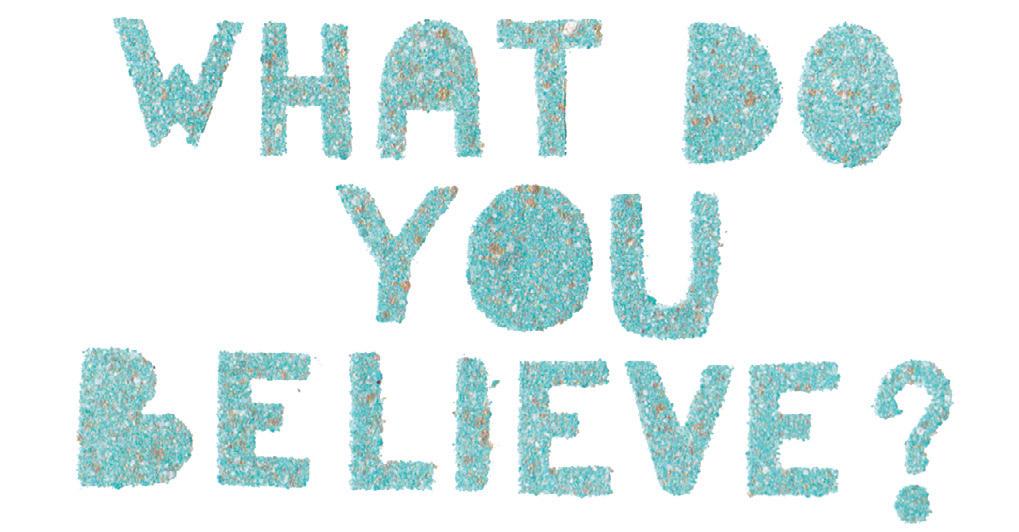
illegally parked in the parking lot. I welcomed him inside to meet Faith so he’d be prepared if he ever needed to get in the apartment when I was gone. He quickly said, “I’ve heard enough complaints about that dog.” I get the feeling sometimes that I’m being harassed because my dog is larger than people are used to in this community. Feeling like I’m being harassed by the residents and now the employees is very uncomfortable.
I’m reminded of something Cesar Millan said, “I train people not dogs.” So true! Training people to ignore her hasn’t been easy, but those who have done so are some of Faith’s biggest fans. I’m hoping this all stops soon. I know some of the residents have had poor experiences with dogs, and I understand that. Some have even started trusting Faith enough to pet her head, and it brings chills of happiness.






































Sitting here in a hospital room with my mama. She’s hanging in but ready to go to the Lord’s house. Guess I’m being selfi sh. I don’t want her to go, but I don’t want her to hurt anymore either. Peaceful but depressing, too. They just gave her a shot. She is resting so good. Been a long time for her to rest like this. I’m happy, but sad too.





Well for ones who doesn’t know, my momma and I haven’t had a great relationship, but we’ve been working hard on it in the last seven years. She my momma. I was a daddy’s girl.
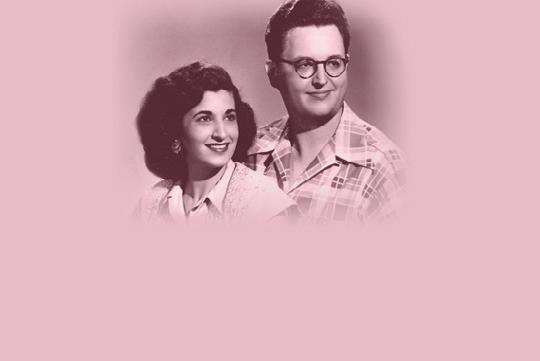








She’s 87 years old. She had a spell with her sugar dropping Christmas Day — dropped to 48. After that she hasn’t been good. Off and on. Day by day. She needs a lot of prayers, you guys. Prayers are very powerful.
Since yesterday, (Jan. 19), she’s back in hospital. Sugar dropped to 32. They’re talking like she might have had a small stroke too.





Please pray for her and your family.
BY CARLA B. & DANNYMe and Carla were walking to the bus stop on Broadway when we walked into a bunch of people who were screaming “No more Trump!” “Impeach Trump out of office!” It was so unique for us to see so many people happy to protest Trump out of office. It felt good to be able to stand in front of hundreds of people making a difference in this world, and to be a part of a very important issue in our country. Me and Carla were amazed by the energy — to have so many people standing for the same thing: Impeaching Trump. Carla said she wouldn’t forget the look on my face proudly holding a sign that read, “Impeach and remove! Trump is not above the law.”
We got on Channel 5 news.
Since the day I got with Carla we have done a lot together. We get to tell people we protested against Trump. That is amazing to be a part of something that will save our country away from Trump.











